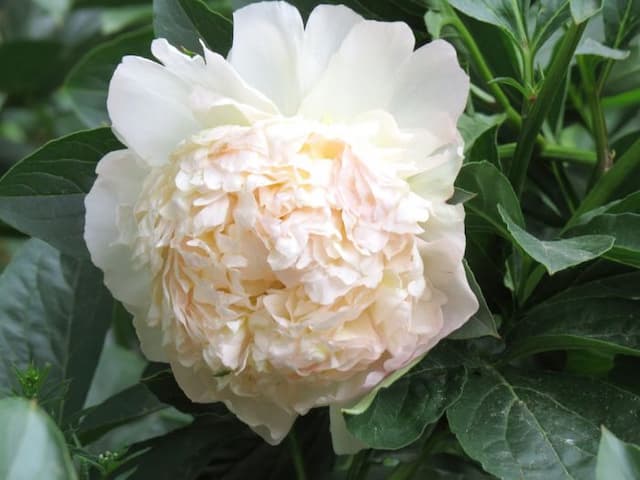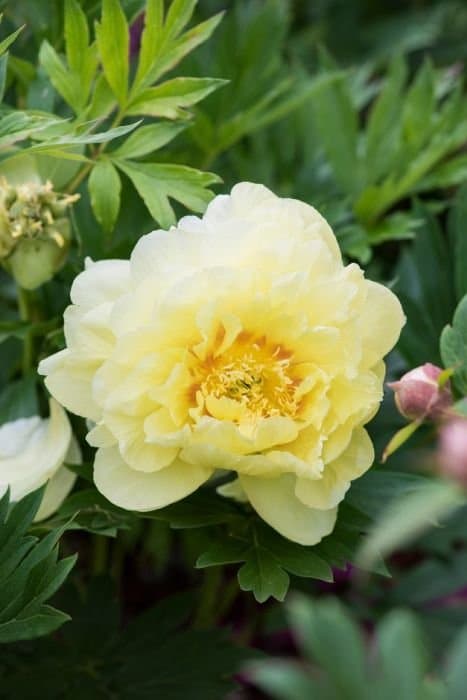Peony 'Monsieur Jules Elie' Paeonia lactiflora 'Monsieur Jules Elie'

ABOUT
'Monsieur Jules Elie' is an herbaceous perennial to 1m tall, with dark green foliage and fragrant, double, deep rose-pink flowers 20cm across in early summer, the petals with a silvery sheen
About this plant
 Names
NamesFamily
Paeoniaceae
Synonyms
Chinese Peony, Common Garden Peony
Common names
Paeonia lactiflora 'Monsieur Jules Elie'.
 Characteristics
CharacteristicsLife cycle
Perennials
Foliage type
Deciduous
Color of leaves
Green
Flower color
Pink
Height
2-3 feet (60-90 cm)
Spread
2-3 feet (60-90 cm)
Plant type
Herb
Hardiness zones
3-8
Native area
East Asia
Benefits
 General Benefits
General Benefits- Aesthetic Appeal: The Paeonia lactiflora 'Monsieur Jules Elie', commonly known as Peony, is highly valued for its large, fragrant pink flowers that add a classic beauty to any garden or landscape.
- Garden Structure: Peonies provide a strong structure to garden beds, with their bushy form and sturdy stems that hold the heavy flowers in spring and summer.
- Longevity: Peonies are known for their impressive longevity, often living and blooming for decades with minimal care.
- Cut Flowers: The blooms are perfect for cutting and creating bouquets, as they have long vase lives and fill spaces with their pleasant fragrance.
- Seasonal Interest: Peonies mark the transition from spring to summer with their lush flowering period, signaling the changing of seasons in a garden.
- Pollinator-Friendly: The blossoms attract pollinators such as bees and butterflies, supporting the local ecosystem.
- Cold Hardy: Peonies are exceptionally cold-hardy, thriving in cooler climates and withstanding harsh winters.
- Low Maintenance: Once established, they require very little maintenance beyond occasional watering and fertilization.
- Drought Tolerance: Mature peony plants have some drought tolerance, making them suitable for gardens in drier climates.
- Disease and Pest Resistance: Peonies are generally resistant to pests and diseases, reducing the need for chemical treatments.
 Medical Properties
Medical PropertiesThis plant is not used for medical purposes.
 Air-purifying Qualities
Air-purifying QualitiesThis plant is not specifically known for air purifying qualities.
 Other Uses
Other Uses- Culinary garnish: The petals of Peony can be used to garnish salads and desserts for a splash of color and a light fragrance.
- Natural dye: The blooms can provide a natural dye for fabrics, offering hues ranging from pink to reddish-purple.
- Floral arrangements: Peony flowers are a popular choice for wedding and event floral arrangements due to their lush, full blooms and sweet scent.
- Photography: Due to their aesthetic appeal, Peony blooms are often used as subjects in botanical and garden photography.
- Art inspiration: The flowers can serve as inspiration for artists, particularly in botanical illustration and watercolor paintings.
- Perfumery: While not a common extract for perfumes, Peony's fragrance can be a component in creating bespoke or artisanal scents.
- Symbolism: Peonies hold cultural significance in certain countries, symbolizing prosperity, good luck, and happiness, thus used in festive decorations.
- Education: Peony plants can be used in educational settings to teach students about botany, hybridization, and plant care.
- Companion planting: Peonies are believed to help protect some vegetables from pests, making them beneficial in a mixed garden setting.
- Ice cubes: Petals can be frozen in ice cubes to create an elegant and decorative element for special occasion drinks.
Interesting Facts
 Feng Shui
Feng ShuiThe Peony is often used in Feng Shui to promote love and romance, therefore placing it in the southwest corner of a garden, room, or home can help attract these energies according to Feng Shui principles.
 Zodiac Sign Compitability
Zodiac Sign CompitabilityThe Peony is not used in astrology practice.
 Plant Symbolism
Plant Symbolism- Honor: The peony, in many cultures, is often associated with honor and high value, which is why it is frequently used in important ceremonies and traditions.
- Romance: Due to their lush and full blooms, peonies are symbolic of romance and romantic love, often seen in wedding bouquets and romantic occasions.
- Prosperity: Peonies are considered good omens for wealth and prosperity, which can be tied to their full, rounded shape symbolizing abundance.
- Beauty: The large and attractive blooms of the peony make it a symbol of beauty in all its forms, celebrating physical and inner beauty.
- Good Fortune: In many traditions, peonies are given as gifts to convey wishes of good fortune and happy life, particularly in Chinese culture.
 Water
WaterFor the Peony 'Monsieur Jules Elie', water the plant deeply once a week, providing about 1 inch of water which roughly translates to 0.623 gallons spread around the root zone. It’s important to allow the soil to dry out somewhat between waterings to prevent root rot. During hot, dry spells in summer, increase watering frequency to twice a week. Reduce watering as the plant goes dormant after flowering and in the fall to encourage hardiness. Always avoid overhead watering to keep the foliage dry and prevent fungal diseases.
 Light
LightPeonies, including 'Monsieur Jules Elie', thrive in full sun, which means they need at least 6 hours of direct sunlight daily. An ideal spot is one where they are protected from the intense afternoon sun, ensuring they receive most of the light in the morning. Partial shade is acceptable, especially in regions with very hot summers, but too much shade can reduce blooming.
 Temperature
TemperaturePeonies like 'Monsieur Jules Elie' are cold-hardy and require a winter chilling period; they can tolerate winter temperatures as low as -20 to -30 degrees Fahrenheit, but the ideal growing temperatures during the growing season range from 65 to 75 degrees Fahrenheit. They can survive in summer temperatures up to 85 degrees Fahrenheit, but flower longevity may be reduced in excessive heat.
 Pruning
PruningPrune your 'Monsieur Jules Elie' peony in the fall, cutting back the faded foliage to ground level after the first frost to help prevent disease. This also tidies up the plant, as peonies die back to the ground each winter. Pruning in the fall is all that’s needed in terms of pruning for peonies; they do not require regular shaping or thinning like some other perennials.
 Cleaning
CleaningAs needed
 Soil
SoilPeonies like 'Monsieur Jules Elie' thrive in well-draining soil enriched with organic matter. A mix of two-thirds garden soil and one-third compost or well-rotted manure is ideal. The pH should be neutral to slightly alkaline, around 6.5 to 7.5.
 Repotting
RepottingPeonies like 'Monsieur Jules Elie' do not need to be repotted often; they prefer to be left undisturbed and can remain in the same spot for many years, up to 10-15 years or longer.
 Humidity & Misting
Humidity & MistingPeonies like 'Monsieur Jules Elie' are not particularly humidity-sensitive and can thrive in the average outdoor humidity levels found in their growing zones.
 Suitable locations
Suitable locationsIndoor
Grow 'Monsieur Jules Elie' peony in bright light; ensure cool temperatures.
Outdoor
Plant in full sun, rich soil, water regularly, mulch, provide space.
Hardiness zone
3-8 USDA
 Life cycle
Life cyclePaeonia lactiflora 'Monsieur Jules Elie', commonly known as the peony, begins its life cycle when the seed germinates in the soil, typically requiring a period of cold stratification to break dormancy. The plant emerges as a seedling in spring and grows rapidly, developing a set of true leaves and establishing a root system. Over the years, the peony matures into a clump-forming perennial with sturdy stems and deep green foliage, reaching full size in 3-4 years. The peony blooms in late spring to early summer, showing off large, fragrant, double pink flowers that attract pollinators. After blooming, the plant sets seed in the form of a capsule if pollination has occurred. In the autumn, the peony's foliage dies back, and the plant enters dormancy, retreating to its underground storage organs (tubers or rhizomes) to survive the winter and begin the cycle anew the following spring.
 Propogation
PropogationPropogation time
Spring-Early Summer
The most popular method of propagation for the Peony 'Monsieur Jules Elie' is by division, which is best done in the fall after the plants have become dormant. To propagate by division, carefully dig up the entire plant, making sure to keep as much of the root system intact as possible. Then, using a sharp knife or garden spade, cut the plant into sections ensuring that each division has at least 3 to 5 eyes, which are the growth nodes where new stems will emerge. Replant each division at the same depth it was growing at originally, spacing them about 3 feet (approximately 0.9 meters) apart to give them ample room to grow. Water the new divisions thoroughly after planting to settle the soil around the roots and help with recovery from the transplanting process.





![Peony [Red Sarah Bernhardt]](/_next/image?url=https%3A%2F%2Fplants-admin.emdemapps.com%2Fimages%2Fplants%2F%2Fimages%2F604b5369d170e.png&w=640&q=75)



